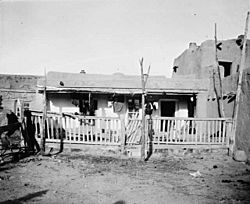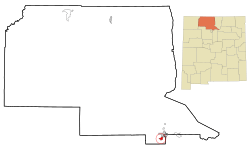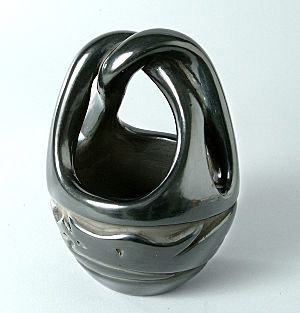Santa Clara Pueblo, New Mexico facts for kids
Quick facts for kids
Santa Clara Pueblo, New Mexico
|
||
|---|---|---|

House at Santa Clara Pueblo, 1910
|
||
|
||

Location of Santa Clara Pueblo
|
||
| Country | United States | |
| State | New Mexico | |
| County | Rio Arriba | |
| Area | ||
| • Total | 2.04 sq mi (5.28 km2) | |
| • Land | 2.02 sq mi (5.23 km2) | |
| • Water | 0.02 sq mi (0.05 km2) | |
| Elevation | 5,670 ft (1,730 m) | |
| Population
(2020)
|
||
| • Total | 930 | |
| • Density | 460.40/sq mi (177.79/km2) | |
| Time zone | UTC-7 (Mountain (MST)) | |
| • Summer (DST) | UTC-6 (MDT) | |
| ZIP code |
87532
|
|
| Area code(s) | 505 | |
| FIPS code | 35-70390 | |
| GNIS feature ID | 2409276 | |
|
Santa Clara Pueblo
|
||
| Lua error in Module:Location_map at line 420: attempt to index field 'wikibase' (a nil value). | ||
| Nearest city | Española, New Mexico | |
| Area | 24 acres (9.7 ha) | |
| NRHP reference No. | 74001199 | |
| Significant dates | ||
| Added to NRHP | November 5, 1974 | |
Santa Clara Pueblo is a special place in New Mexico, United States. Its name in the Tewa is Khaʼpʼoe Ówîngeh, which means "Singing Water Village." It's also known as "Village of Wild Roses." This area is home to a federally recognized tribe of Native American Pueblo people.
The Santa Clara Pueblo is part of the Eight Northern Pueblos. The people here are from the Tewa group. They speak the Rio Grande Tewa language. The pueblo is located along the Rio Grande river. It sits between Ohkay Owingeh to the north and San Ildefonso Pueblo to the south.
Santa Clara Pueblo is very well-known for its beautiful, handmade pottery. They create special blackware and redware pieces. These often have deep, carved designs. The pueblo is officially listed on the National Register of Historic Places.
Contents
Geography and Location
Santa Clara Pueblo is found about 1.5 miles south of Española. You can reach it by taking NM 30.
The area of the pueblo is about 2.1 square miles (5.4 square kilometers). This entire area is land.
Population and People
| Historical population | |||
|---|---|---|---|
| Census | Pop. | %± | |
| 2020 | 930 | — | |
| U.S. Decennial Census | |||
In 2020, about 930 people lived in the Santa Clara Pueblo area. The people of Santa Clara Pueblo are part of the Tewa ethnic group. They have a rich cultural history.
History of Santa Clara Pueblo
Tewa people have lived in the Pueblo area for thousands of years. They were here long before Spanish explorers arrived. The first Spanish explorers met the people here in 1541. Later, in 1598, Juan de Oñate and his group visited the area.
Over time, the Spanish built a chapel in the area by 1617. A mission was set up in 1628. However, this mission was later left empty before the Great Pueblo Revolt of 1680.
In 1680, the Santa Clara Pueblo joined other pueblos. They fought against the Spanish government in the Pueblo Revolt. During this time, the original chapel was destroyed. Two more chapels were built later. The church you see today was built in 1918.
In 1782, a terrible smallpox disease spread. It greatly reduced the population of the pueblo. In 1854, the United States government began to count people and review land ownership. The pueblo showed a Spanish paper from 1713. This paper protected their right to their homeland. Because of this, Santa Clara Pueblo was one of the first Native American communities officially recognized by the United States Congress.
Education for Children
Children in Santa Clara Pueblo attend schools in the Española Public Schools district. The main public high school for students is Española Valley High School.
There is also a special tribal elementary school in Santa Clara Pueblo. It is called Kha'p'o Community School. This school is connected with the Bureau of Indian Education (BIE).
Arts and Pottery
One of the most famous arts from Santa Clara Pueblo is pottery. For a long time, girls and women were the main potters. Today, many women still make pottery, but many men do too. Santa Clara Pueblo potters are known for their shiny black and red pottery. They use a special style with deep carvings. Designs like the "Knife-wing" or eagle feather are often seen on their pottery.
There are four main ways they decorate their pottery:
- Painting designs on the surface.
- Pressing patterns into the clay.
- Carving designs into the clay.
- Using a special firing method with carved designs.
Famous People from Santa Clara Pueblo
Many talented artists and leaders come from Santa Clara Pueblo. Here are a few:
- Angela Baca: A famous potter known for "melon pots."
- Gregory Cajete: An author and educator.
- Jody Folwell: A well-known potter.
- Tammy Garcia: An artist who creates ceramics and sculptures.
- Margaret and Luther Gutierrez: A husband and wife team of potters.
- Joseph Lonewolf: A skilled potter.
- Jody Naranjo: An artist.
- Nora Naranjo Morse: An artist and filmmaker.
- Linda and Merton Sisneros: Potters.
- Paul Speckled Rock: A potter and sculptor.
- Anita Louise Suazo: A traditional potter.
- Roxanne Swentzell: A sculptor and activist for native plants.
- Rose B. Simpson: An artist who works with many different materials.
- Margaret Tafoya: A very famous traditional potter from Santa Clara.
- Pablita Velarde: A well-known painter.
- Nathan Youngblood: A potter.
See also
 In Spanish: Pueblo de Santa Clara para niños
In Spanish: Pueblo de Santa Clara para niños




